Measuring a cup accurately can be tricky when you don’t have the right tools. But don’t worry, there are some clever ways to estimate a cup using everyday items found in your kitchen or around the house. These methods will help you approximate the standard cup measurement (which is typically 240 milliliters or 8 fluid ounces) when your measuring cups are out of reach.
Everyday Objects as Cup Substitutes
What can you use if you don’t have a measuring cup? Here are a few common household items that can help you in a pinch:
- A regular teacup or coffee mug: While these vary in size, a standard teacup or coffee mug often holds close to a cup. Be mindful of oversized mugs, which can significantly exceed a cup’s volume. This method is best for situations where precise measurements are not critical.
- A standard drinking glass: Many drinking glasses hold around 8 ounces, equivalent to a cup. Check the base of the glass, as some indicate their capacity. This can be a reliable alternative to a measuring cup.
- A small bowl: Certain small bowls, particularly cereal bowls, can hold roughly a cup. Compare the bowl to the size of your usual measuring cup to estimate its capacity. Again, this method offers an approximation rather than precise measurement.
- A handful: While not the most accurate, a cupped hand can hold approximately half a cup of dry ingredients. This method is most useful in a pinch when dealing with non-liquid ingredients.
For those who frequently bake or cook, having accurate measuring tools is vital. If you need a refresher on standard conversions, check out how many tbsp in a cup. This will remind you of the tablespoons-to-cups ratio.
Estimating a Cup Using Common Containers
You can also use familiar containers to approximate a cup measurement:
- A standard soda can: These usually contain 12 fluid ounces, or about half a cup. Two soda cans combined will give you approximately one cup.
- A small yogurt container: Individual yogurt cups often hold around 6 ounces, which means that a little more than one and a half containers will equate to a cup.
- A water bottle: Many standard water bottles are 16 ounces, or two cups. Half a standard water bottle will be close to one cup.
Remember, these are estimates. For more precise liquid measurements, you might find our guide on cups to milliliters helpful. It provides a clear conversion table for accurate measuring.
How to Measure a Cup Using Your Hand
In situations where even these approximate measuring tools are unavailable, you can use your hand:
- Cup your hand slightly. Imagine you are holding water.
- Fill your cupped hand. This will give you a rough estimate of approximately half a cup.
- Repeat the process. Two cupped handfuls will approximate one cup.
This method works best for dry ingredients. It’s important to remember that hand sizes vary, so this provides a very rough estimate. It may be useful to compare your hand size to the known volume of a familiar container, such as a small bowl, to get a more personalized estimate.
For those working with smaller measurements, knowing how much is 1 oz in cups can be extremely beneficial, especially when dealing with ingredients like spices or extracts.
Tips for Accurate Measurement Without Tools
Even without measuring tools, you can improve the accuracy of your estimations:
- Compare with known quantities: If you have a can of soup you know is 10 ounces, use it to visually compare with other containers.
- Practice: Regularly estimating will improve your ability to judge volume.
If you’re unsure about conversions, a handy resource like 120 ml to cups can clarify metric measurements in relation to cups. This is especially helpful for international recipes.
Conclusion: Measuring Without Tools
Measuring a cup without measuring tools requires resourcefulness and a bit of estimation. By using everyday objects, familiar containers, or even your hand, you can approximate a cup measurement when in a bind. While not perfectly precise, these techniques can help you continue cooking or baking without interruption. For accurate measurements, always use standard measuring tools.
FAQ
- What’s the standard cup measurement? A standard cup is 8 fluid ounces or 240 milliliters.
- Is using my hand to measure accurate? No, it’s a rough estimate. Hand sizes vary.
- What’s the best alternative to a measuring cup? A drinking glass or soda can are often good approximations.
- Why is accurate measurement important in cooking? Accurate measurement ensures your recipes turn out as intended.
- Where can I find accurate conversions for different units? Online converters and cookbooks are great resources.
- What if I need to measure small amounts like spices? Try estimating using a fraction of a teaspoon or tablespoon.
- Are there any other household items I can use to estimate a cup? Small bowls or yogurt containers can be helpful.
Need more help with conversions? Check out 30 grams to cups. This guide can be especially helpful when baking.
Have other measurement questions? Browse our website for more conversion guides and helpful tips.
Need help? Contact us at Phone Number: 0372999996, Email: bong.da@gmail.com or visit us at 236 Cầu Giấy, Hà Nội. We have a 24/7 customer service team.

